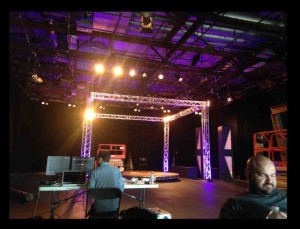Lighting is one of the most important components to quality production. Without lighting all of television would just be radio.
Proper lighting completes a scene by enhancing the look of the scene and enabling the viewer to attach emotionally to what’s happening on the screen . Directors cannot always rely on natural lighting to accomplish their vision due to timing or elements so they create their own effects with the help of a gaffer and the lighting team in a more controlled environment.
Duties
In the entertainment industry the head of the electrical department is known as the chief lighting technician (CLT) or the gaffer. The gaffer answers to the Director of Photography (DP) or Lighting Director (LD), who helps interpret the director’s vision for the overall look of the project. Assisting the gaffer are the best boy electric (assistant CLT) and a crew of technicians generally called electricians, lamp operators or juicers.
The gaffer is tasked with designing the lighting plot for each shot of a film or TV show. (In some cases a lighting director may handle this duty on a television set.) The gaffer selects the proper instruments for each shot based on the environment, camera angles, desired effect, and available ambient lighting. The gaffer adjusts color temperature with the use of colored gels and manipulates the direction and intensity of light by using barn doors, flags, and reflectors. The set-up of all lighting instruments, cables, generators, and accessories is directed by the gaffer, supervised by the best boy, and carried out by the crew of electricians. During the filming of the scene the gaffer monitors the lighting conditions, while the electricians and grips are tasked with holding flags or reflectors and operating other lighting effects for complex shots such as action sequences. After the shot, the electricians tear down the gear and move on to set up the next one. As a department, the gaffer and electricians are responsible for the operation, maintenance, and repair of all electrical (not audio or camera) equipment on set. A gaffer will typically have his or her own truck stocked with a basic lighting kit, and will rent additional gear as needed.
Skills & Education
You are not expected to have a specific degree to become an electrician or gaffer, but you will need experience and training in film/TV production. A college education in this field is a great place to start to build your résumé and compile a demo reel of your work. Student films and independents are the best way to start learning the trade. Work in the electrical department requires knowledge of lighting equipment, electricity, and color theory. Courses in art, photography, and electrical engineering are helpful. Most electricians at all levels must become members of the International Alliance of Theatrical Stage Employees, the union that represents technicians in film, TV, and theater. IATSE offers an apprenticeship program to learn the craft, and requires members to complete specific training and safety courses.
What to Expect
To become a gaffer you will have to spend years working your way up the ladder. To get your foot in the door, look for opportunities as an intern with a production company or jobs as an on-set production assistant or PA. You will have to do a lot of grunt work before you land a slot in the electrical department, but once you prove that you are a hard worker and reliable, you will be given the chance to take on more responsibility. A good attitude and willingness to learn is key, and a sense of humor and lack of ego will help you fit in with the crew. Stress and long hours are part of the package. Cultivating a successful career in film/TV production takes commitment; results rarely come quickly, but a comfortable living can be made as a gaffer.




